Bedworth: Difference between revisions
No edit summary |
|||
| Line 15: | Line 15: | ||
|constituency=North Warwickshire | |constituency=North Warwickshire | ||
}} | }} | ||
'''Bedworth''' is a | '''Bedworth''' is a market town in [[Warwickshire]], 19 miles east of the county's greatest city, [[Birmingham]], and 15 miles north-north-east of the [[county town]], [[Warwick]]. Bedworth stands between [[Coventry]], 5½ miles to the south, and [[Nuneaton]], three miles to the north. | ||
==About the town== | ==About the town== | ||
[[File:All Saints Church of England Parish Church, Bedworth - geograph.org.uk - 583153.jpg|left|thumb|200px|All Saints Church]] | [[File:All Saints Church of England Parish Church, Bedworth - geograph.org.uk - 583153.jpg|left|thumb|200px|All Saints' Church]] | ||
[[File:Almshouses, Bedworth.jpg|left|thumb|200px|Nicholas Chamberlaine Almshouses]] | [[File:Almshouses, Bedworth.jpg|left|thumb|200px|Nicholas Chamberlaine Almshouses]] | ||
The most notable buildings in Bedworth are the parish church, All Saints, and Nicholas Chamberlaine Almshouses on All Saint's Square in the town centre | The most notable buildings in Bedworth are the parish church, All Saints', and Nicholas Chamberlaine Almshouses on All Saint's Square in the town centre | ||
All Saints dominates the town centre. The church was rebuilt in the late 19th century of [[Runcorn]] stone in the Decorated style. The church has a square bell tower from the original Church thought to date from 1450 which houses the Town Clock (1817), and a peal of eight bells. The church has several fine stained glass windows. | All Saints' dominates the town centre. The church was rebuilt in the late 19th century of [[Runcorn]] stone in the Decorated style. The church has a square bell tower from the original Church thought to date from 1450 which houses the Town Clock (1817), and a peal of eight bells. The church has several fine stained glass windows. | ||
The Almshouses are built in Tudor style, from funds of the will of the local benefactor Nicholas Chamberlaine (1632–1715). | The Almshouses are built in Tudor style, from funds of the will of the local benefactor Nicholas Chamberlaine (1632–1715). | ||
| Line 40: | Line 40: | ||
Originally a small market town with Anglo-Saxon origin, Bedworth developed into an industrial town in the 18th and 19th centuries, due largely to coal mining and the overspill of ribbon weaving and textile industries from nearby Coventry.<ref name="Slater 1981">Slater, Terry (1981) ''A History of Warwickshire'', ISBN 0-85033-416-0</ref><ref name="bedworth-society.co.uk">[http://www.bedworth-society.co.uk/about%20bedworth.html The Bedworth Society - About Bedworth]</ref> The opening of the Coventry Canal in 1769 and later, the railway in 1850 enhanced the town's growth.<ref name="Slater 1981"/> Until quite recently Bedworth was primarily a coal mining town, but the last colliery was closed in 1994.<ref name="bedworth-society.co.uk"/> In the middle of the Nineteenth century, the large number of public houses, and thirsty miners lead to the town being called 'Black Bedworth'. | Originally a small market town with Anglo-Saxon origin, Bedworth developed into an industrial town in the 18th and 19th centuries, due largely to coal mining and the overspill of ribbon weaving and textile industries from nearby Coventry.<ref name="Slater 1981">Slater, Terry (1981) ''A History of Warwickshire'', ISBN 0-85033-416-0</ref><ref name="bedworth-society.co.uk">[http://www.bedworth-society.co.uk/about%20bedworth.html The Bedworth Society - About Bedworth]</ref> The opening of the Coventry Canal in 1769 and later, the railway in 1850 enhanced the town's growth.<ref name="Slater 1981"/> Until quite recently Bedworth was primarily a coal mining town, but the last colliery was closed in 1994.<ref name="bedworth-society.co.uk"/> In the middle of the Nineteenth century, the large number of public houses, and thirsty miners lead to the town being called 'Black Bedworth'. | ||
Due to its good transport links, and proximity to major cities such as [[Coventry]], [[Birmingham]] and [[Leicester]], Bedworth is now growing rapidly as a | Due to its good transport links, and proximity to major cities such as [[Coventry]], [[Birmingham]] and [[Leicester]], Bedworth is now growing rapidly as a dormitory town. | ||
==Sport and leisure== | ==Sport and leisure== | ||
Latest revision as of 19:28, 5 July 2018
| Bedworth | |
| Warwickshire | |
|---|---|
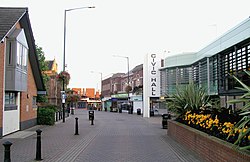 Bedworth town centre and civic hall | |
| Location | |
| Grid reference: | SP3586 |
| Location: | 52°28’30"N, 1°28’37"W |
| Data | |
| Population: | 32,268 (2001) |
| Post town: | Bedworth |
| Postcode: | CV12 |
| Dialling code: | 024 |
| Local Government | |
| Council: | Nuneaton and Bedworth |
| Parliamentary constituency: |
North Warwickshire |
Bedworth is a market town in Warwickshire, 19 miles east of the county's greatest city, Birmingham, and 15 miles north-north-east of the county town, Warwick. Bedworth stands between Coventry, 5½ miles to the south, and Nuneaton, three miles to the north.
About the town
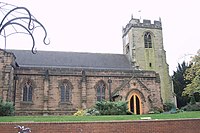
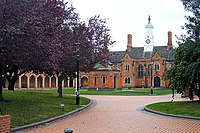
The most notable buildings in Bedworth are the parish church, All Saints', and Nicholas Chamberlaine Almshouses on All Saint's Square in the town centre
All Saints' dominates the town centre. The church was rebuilt in the late 19th century of Runcorn stone in the Decorated style. The church has a square bell tower from the original Church thought to date from 1450 which houses the Town Clock (1817), and a peal of eight bells. The church has several fine stained glass windows.
The Almshouses are built in Tudor style, from funds of the will of the local benefactor Nicholas Chamberlaine (1632–1715).
The main venue in Bedworth is the Bedworth Civic Hall which has an attached arts centre.
The Bedworth water tower is probably the most noticeable landmark building in Bedworth, in the style of Edwin Lutyens, visible from miles around and built in the 19th century. It used to provide water for the houses and the mining facilities.
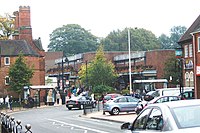
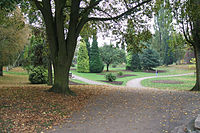
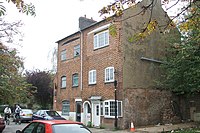
Along Mill Street until recently were rows of former weavers' cottages which were once inhabited by Huguenot weavers. Some of these were still used as shops, although most had been allowed to become derelict. They have been demolished as part of a redevelopment.
The majority of the town centre was built in the postwar period, and has all the hallmarks of such a development. The town centre itself contains some of the usual high street retail names as well as many charity, card shops and banks.
History
Originally a small market town with Anglo-Saxon origin, Bedworth developed into an industrial town in the 18th and 19th centuries, due largely to coal mining and the overspill of ribbon weaving and textile industries from nearby Coventry.[1][2] The opening of the Coventry Canal in 1769 and later, the railway in 1850 enhanced the town's growth.[1] Until quite recently Bedworth was primarily a coal mining town, but the last colliery was closed in 1994.[2] In the middle of the Nineteenth century, the large number of public houses, and thirsty miners lead to the town being called 'Black Bedworth'.
Due to its good transport links, and proximity to major cities such as Coventry, Birmingham and Leicester, Bedworth is now growing rapidly as a dormitory town.
Sport and leisure
- Football: Bedworth United FC play at the Oval Ground
Outside links
- The Bedworth Society
- Nuneaton and Bedworth Borough council
- Bedworth United FC
- The Civic Hall, Bedworth
- 1st Bedworth Scout Group, Bedworth
- Photos of Bedworth and surrounding area on geograph.org.uk
- Bedworth Connect Directory
- Churches
References
- ↑ 1.0 1.1 Slater, Terry (1981) A History of Warwickshire, ISBN 0-85033-416-0
- ↑ 2.0 2.1 The Bedworth Society - About Bedworth